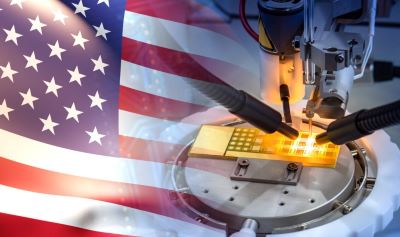
Vinita Gupta-
Technology is the king of the new era …
The 2022 CHIPS and Science Act provides $52.7 billion over five years, for American semiconductor research, development, manufacturing, and workforce development. The foundational technology of semiconductors (the chips) permeates our military. But it also will result in a viable path to peace and to US economic progress in the 21st century.
Semiconductor chip making is highly intricate. On a small piece of silicon (less than the size of a fingernail), deposits of different materials create an on/off switch — called a transistor — instead of the lightbulb-size vacuum-tube switch of WWII years. When these transistors are interconnected they can perform mathematical calculations. That is why they are used in computers, spaceships, defense equipment & weapons but also in refrigerators.
This research, funded by taxpayers, is done at universities, defense labs, and industries across the United States. Since the mid-1970s, the size of transistors on silicon keeps shrinking making them cheaper to produce. At the same time, they consume less power. As a result, the switches are less likely to bleed into each other. The switch also can be turned on/off faster as research in the material sciences has progressed. To reap the full benefit of these advancements, the fabrication done on assembly lines requires continued new investments. The fabrication must be done in a cleanroom environment that is free of dust and with tightly controlled temperature and moisture.
Taiwan is the world’s leading manufacturer of semiconductor chips, with a 90% market share. The country has continued to modernize its plants to keep pace with technology. In contrast, China has virtually no chip manufacturing capabilities. The US, however, initiates new chip designs and is the dominant player in R&D.
China is a geopolitical threat to the semiconductor industry: China has been promoting its ‘One-China’ principle, claiming that in 1971, UN Resolution 2578 recognized one China only, implying that Taiwan was not a separate country. The UN member states do not accept that interpretation.
Along with its own principle, China has been recently flexing its muscles in the South China Sea. This is another threat to the US and its allies.
The 2022 CHIPS Act was passed with bipartisan support. It will and has already incentivized US manufacturers like Intel and Micron to invest in building US manufacturing fabs, partly with government funding. It takes $20 billion to build a single fab in the US, based on the most recent 4 nanometers technology.
The CHIPS Act also ensures that R&D for new advanced chips will be funded for AI and quantum computing, the technologies of the future, in readiness for World War III.
At the same time, the US must support Taiwan, which has 30 years of leadership in manufacturing and a trained workforce. It must rally its allies, including Taiwan, to sanction chips from going into China, where they can be used in military systems against us.
The CHIPS Act has already incentivized US manufacturers to start building new fabs.
Historically the credit for investments in private-public partnerships was recognized and initiated soon after World War II by Vannevar Bush, founder of Raytheon, a scientist himself, and head of Scientific Research and Development (OSRD) during World War II. OSRD carried out all military R&D during the war.
Vannevar in his report in 1945 wrote, “basic research is essentially noncommercial in nature. It will not receive the attention it requires if left to industry… The industry will fully rise to the challenge of applying new knowledge to new products. The commercial incentive can be relied upon for that.”
On his recommendation, the NSF and the Office of Naval Research were established. Government funding to ATT’s Bell labs made the invention of the transistor possible. “Bell Labs scientists John Bardeen, Walter Brattain, and William Shockley won the 1956 Nobel Prize in Physics for their invention of the transistor, a small semiconductor device that would change the world.”
And it did.
Then came globalization. Today a semiconductor chip crosses 70 international borders before it is shipped in a consumer product like iPhone. From start to finish it touches 46 different countries.
The economic advantages of globalization have been enormous, especially for semiconductors. Each country focuses on what it does best — bringing the quality up and prices down. Competition is the name of the game in a capitalistic economy.
So the landscape of the new battlefield is different. Yet the flexibility of the supply chain must be maintained. Partnership with allies is important. The new economy’s strength is a cooperative approach based on trust and transparency. It is unlikely that authoritarian or protectionist regimes like China and Russia will be able to compete.
The Ukraine war is living proof of how superior technology and economic sanctions can work. A giant country like Russia was pushed back by a tiny, disorganized, and supposedly corrupt Ukraine.
The CHIPS Act is a necessary but not a sufficient solution for the problems of the 21st century. We must continue to embrace globalization, cultivate and rely on the supply chain of allies, and keep their protection, especially that of Taiwan, on our radar.
The semiconductor is the future and will hopefully lead the world away from the temptation of war.






